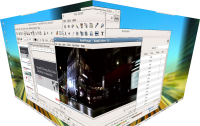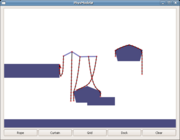 CompizSharp
CompizSharp
From NDesk
Contents |
[edit] compiz-sharp: OpenGL desktop compositing framework for .NET
compiz-sharp was written as part of the Google Summer of Code 2006 for the Mono project.
compiz-sharp provides a means of driving OpenGL compositing and window management in the X Window System (Xgl) using the Mono framework. Desktop effects can be provided concurrently by individual effect plugins with their logic written purely in a CLS-compliant language supported by Mono, such as C#. The infrastructure itself is implemented with a combination of C "glue" code and C#.
Sample effect plugins are included to demonstrate a subset of functionality available to plugin authors.
The project achieves its goals by extending compiz non-invasively as a regular compiz plugin which hosts the Mono runtime. To allow this, the maintainers of compiz have provided hooks for plugin loader plugins based on feedback from this project.
The API exposed by the binding covers the subset of entry points needed to create functional effect plugins, and is close to providing complete coverage of all relevant public API. The managed (C#) API follows the naming conventions and style of the CLR and existing Mono libraries, making it easy for developers to get started. Writing complex 3D desktop effects has never been easier!
Managed plugins can implement effects by changing the behaviour of existing plugins or by using Mono's Tao OpenGL library. This library has recently been updated with a new build system that will help make it widely available in Linux distributions and more accessible to developers.
[edit] Physics model
During development, compiz-sharp got its own physics model. This is based on Akamaru, which is a generalised version of the model used in compiz with a different numerical integration technique. Similar algorithms were previously implemented by Luminocity and the sproing prototype in cairo-demo.
To users, this kind of physics model is best known for providing desktop effects like wobbly windows in compiz and the Mac OS X dock animations. It has also been used for character animation in the movie industry and computer games.
[edit] Building
The build system currently has two stages.
The glue part of the binding is implemented as a compiz plugin and can be built with ./configure and make etc.
The managed part of the binding exists in src/. It can be built by entering that directory and running make.
The example plugins are in plugins/ and can be compiled after src/ has been built. Certain plugins depend on the physics model and will need the code in physics/ to be built first.
The modularity of the binding means that you don't need Tao unless you intend to use OpenGL and similarly, the physics model is an optional extra provided to make writing slick effects fun and easy by abstracting the underlying algorithms.
[edit] Download
The source code is maintained in git:
git-clone git://git.ndesk.org/pub/scm/compiz-sharp

